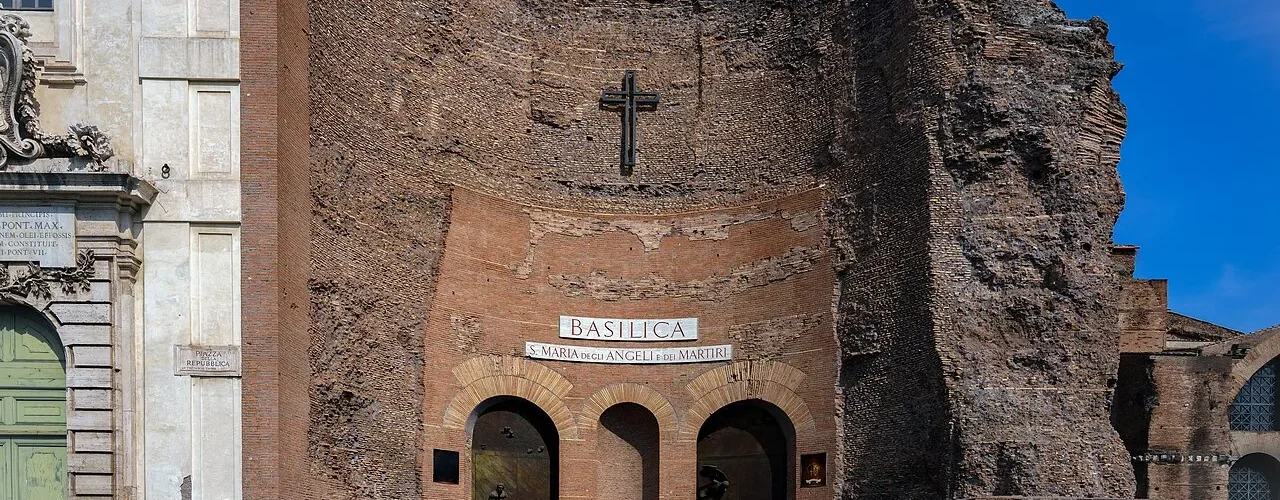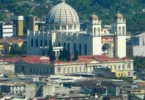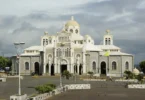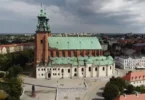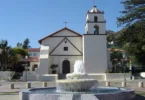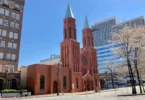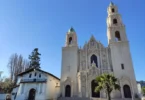Introduction
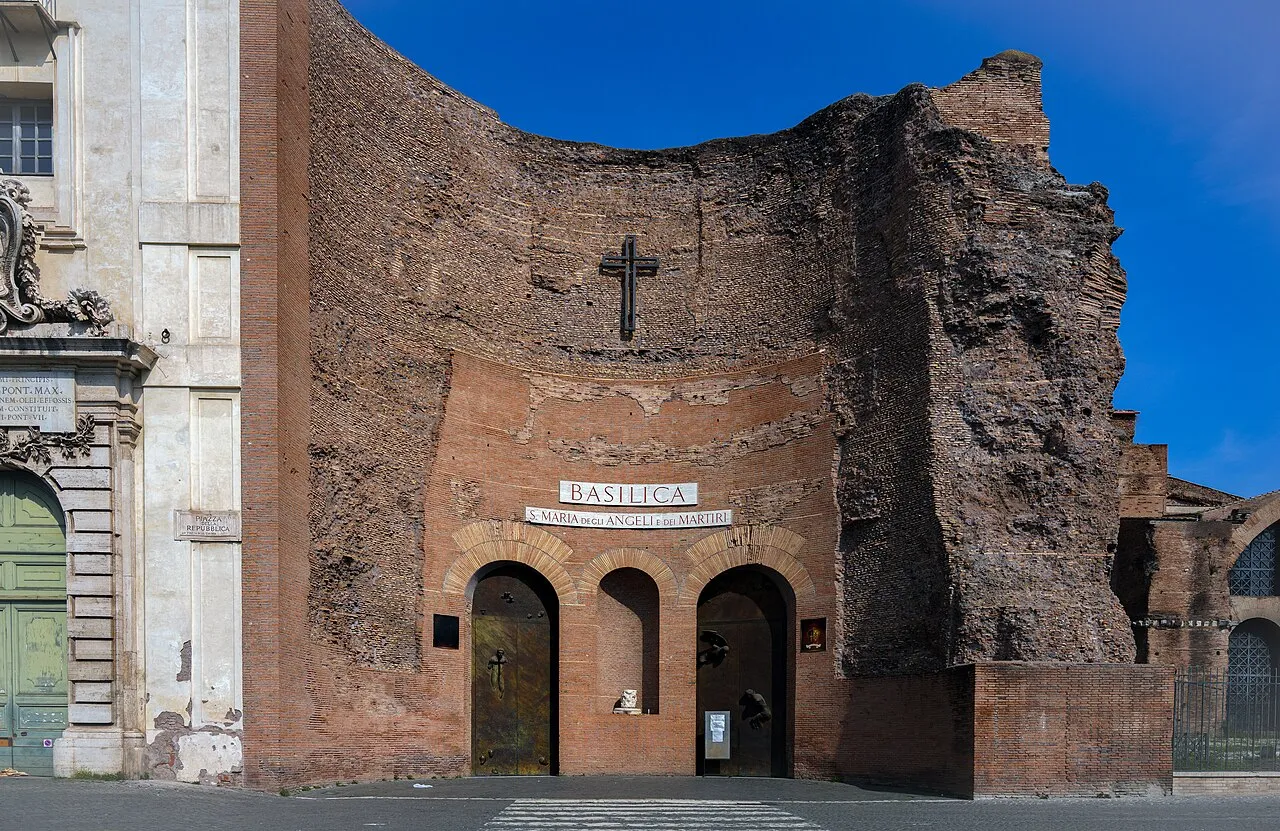
The Basilica of Santa Maria degli Angeli e dei Martiri, located in Piazza della Repubblica in Rome, is a significant Catholic place of worship. Originally constructed in the 16th century, the church was built in the ruins of the frigidarium and tepidarium of the Roman Baths of Diocletian. Michelangelo Buonarroti designed the church, and over the following centuries, additional architects and artists contributed to its development.
This basilica serves as the site for official ceremonies of the Italian Republic, underscoring its importance in both religious and national contexts. It was once a Carthusian conventual church and was later elevated to a titular minor basilica. During the Kingdom of Italy, it was also used for various religious state functions. The church’s rich history and stunning architecture make it an enduring symbol of Rome’s cultural and religious heritage.
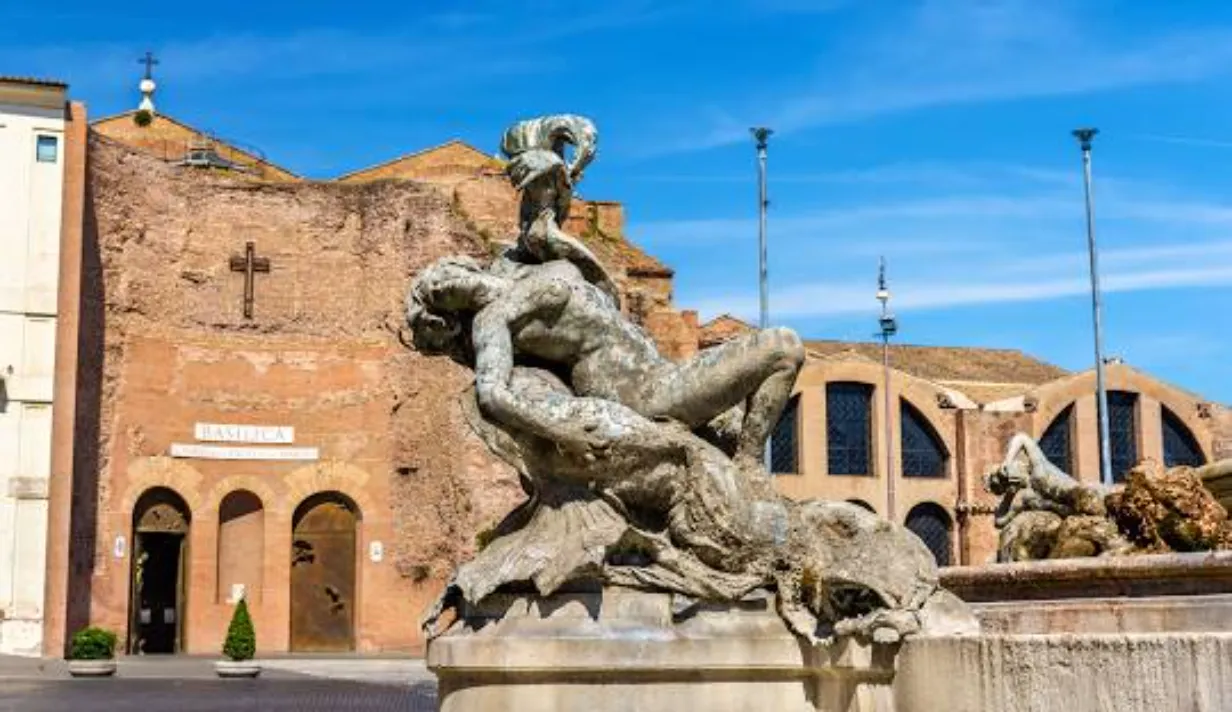
The Basilica of Santa Maria degli Angeli e dei Martiri in Rome has a rich history that dates back to the 16th century. The church was conceived in 1562 by Pope Pius IV, who commissioned Michelangelo Buonarroti to repurpose the central hall (frigidarium) of the Roman Baths of Diocletian. The idea was initially proposed by Antonio Del Duca, a Sicilian priest and uncle of Michelangelo’s disciple, Giacomo Del Duca. Antonio had a vision in 1541 where he saw a “light more than white snow” rising from the Baths, with seven martyrs in the center. This vision convinced him that a church dedicated to the seven angels and martyrs must be built. Despite his long advocacy, Pope Paul III did not support the idea, but the vision persisted.
In 1543, Del Duca commissioned a painting of the Madonna surrounded by seven angels, inspired by a mosaic from the Basilica of San Marco, which now resides in the apse of the church. The idea for the church gained traction with the election of Pope Julius III, and work began under subsequent papacies, particularly with Pope Pius IV’s bull in 1561, which formally authorized its construction. The church took the name “Beatissimae Virgini et omnium Angelorum et Martyrum” (Blessed Virgin and All Angels and Martyrs).
Michelangelo was entrusted with the project and approached the thermal complex with a modern, non-destructive attitude. He worked within the existing structure, adding partitions and cross vaults to create a unique ecclesiastical space. The design emphasized lateral rather than longitudinal space. The church’s main axis ran from the vestibule to the choir, situated in the natatio area. After Michelangelo’s death, his nephew Giacomo Del Duca continued the work, and the project extended into the 18th century.
In the 18th century, Luigi Vanvitelli undertook significant renovations to restore the architectural unity of the church. His work included the addition of eight masonry columns and a tympanum portal, creating a more uniform design. Vanvitelli also transported several important paintings from St. Peter’s Basilica to Santa Maria degli Angeli, turning it into a rich art gallery. Some notable works include Domenichino’s Martyrdom of St. Sebastian, Pompeo Batoni’s Fall of Simon Magus, and Carlo Maratta’s Baptism of Jesus.
With the unification of Italy, the Carthusian monks were removed, and the church underwent several transitions, serving military purposes before becoming a diocesan church. In 1920, Pope Benedict XV elevated the church to a minor basilica. Today, the Basilica of Santa Maria degli Angeli e dei Martiri continues to serve as a state church and is often used for state funerals. It also holds a section of the National Roman Museum in the adjacent former Carthusian monastery.
Architecture of Basilica of St. Mary of the Angels and the Martyrs, Rome, Italy
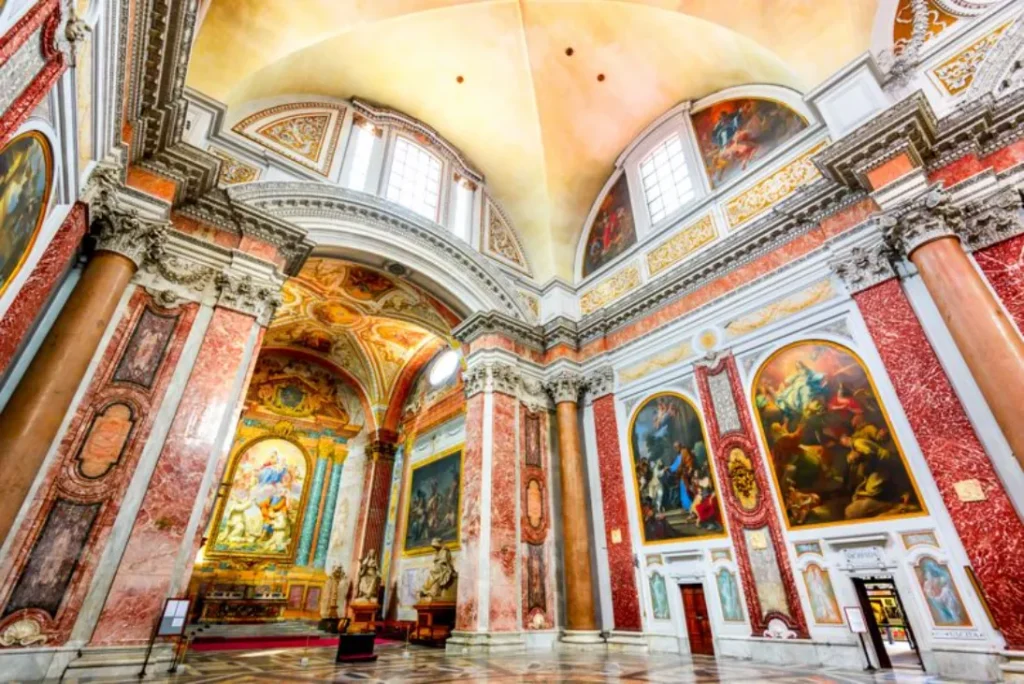
External Entrance
In the early 20th century, restorations removed the Vanvitelli façade, and in 1911, it was transformed into a large exedra niche with two arched entrances, aimed at restoring the original appearance of the basilica. On 28 February 2006, the old wooden doors were replaced with new ones crafted by Polish sculptor Igor Mitoraj.
The Right Door
The right door portrays the Annunciation theme. The top of the left panel features an angel, while the right panel, lower down, depicts the Virgin Mary, with a background of the world. The lunette above shows a group of angels, their heads bandaged, with the body of a headless young woman.
The Left Door
The left door illustrates the Resurrection theme. The left panel features the crucifixion, with a deeply carved human figure on a cross. In the background, there is a bandaged head and a palm. The lunette above shows figures representing martyrs. The lunettes are designed to symbolize the basilica’s dedication to angels and martyrs. The back of the doors displays panels with four archangels.
Circular Vestibule
The circular vestibule, a domed passage hall, likely stood in the location of the ancient nymphaeum of the Baths of Diocletian. This hall was situated between the calidarium, which no longer exists, and the tepidarium. Michelangelo Buonarroti incorporated it into the longitudinal axis of the church, adding four aedicules with tympani to preserve several funerary monuments.
Funerary Monuments in The Circular Vestibule
The circular vestibule of the Basilica of Santa Maria degli Angeli e dei Martiri houses several notable funerary monuments. One such monument is the Funeral Monument to Carlo Maratta, designed by Maratta himself, which includes a painting of The Baptism of Jesus. The monument also features a marble bust of Maratta created by Francesco Maratta, although the two were not related. Another significant memorial is the Monument to Cardinal Francesco Alciati, which was completed three years after his death. This monument is housed in a shrine with a tympanum supported by Ionic columns. The sarcophagus rests on a pedestal, with a bust and coat of arms in the center, supported by four pilasters. While Vanvitelli credits Jacopo Del Duca with its construction, A. Schiavo attributes it to Giovan Battista Della Porta. The Funeral Monument to Cardinal Pier Paolo Parisio, erected in 1604 by his nephew, Flaminio, Bishop of Bitonto, recalls the style of Michelangelo’s tomb designs. Lastly, the Monument to Salvator Rosa, dedicated in 1673 by his son, Augusto, features the painter emerging from a sarcophagus, supported by two cherubs symbolizing painting and poetry. This beautiful monument was sculpted by Bernardino Fioriti.
Chapels of the Circular Vestibule
The Chapel of the Crucifix was constructed in 1575, as evidenced by an underground inscription, and was commissioned by the wealthy Roman banker Girolamo Ceuli. The altar canvas, attributed to Giacomo della Rocca, depicts the Crucifixion and is accompanied by frescoes on the vault, although these were poorly restored in 1838. On the left wall, there is a tomb dedicated to Pietro Tenerani, designed as a shrine with a tympanum supported by Ionic columns. In the center of the shrine is a bust of the artist, and on the base, a door is depicted, symbolizing the passage to Hades. On the opposite side of the chapel stands the monument to Tenerani’s wife, Lilla Montabbiio, which takes the form of a simple shrine with a tympanum and Corinthian columns.
The Chapel of the Magdalene and Baptistery was built in 1579 by Consalvo Alvaro di Giovanni. The altarpiece, bearing the epitaph “Noli me tangere,” is attributed by some to Cesare Nebbia, while others credit it to Arrigo Fiammingo. The painting portrays the resurrected Jesus appearing to Mary Magdalene as a gardener. Once she recognizes him, he exhorts her not to touch him, uttering the famous phrase “Noli me tangere.”
Other Works Located in the Room
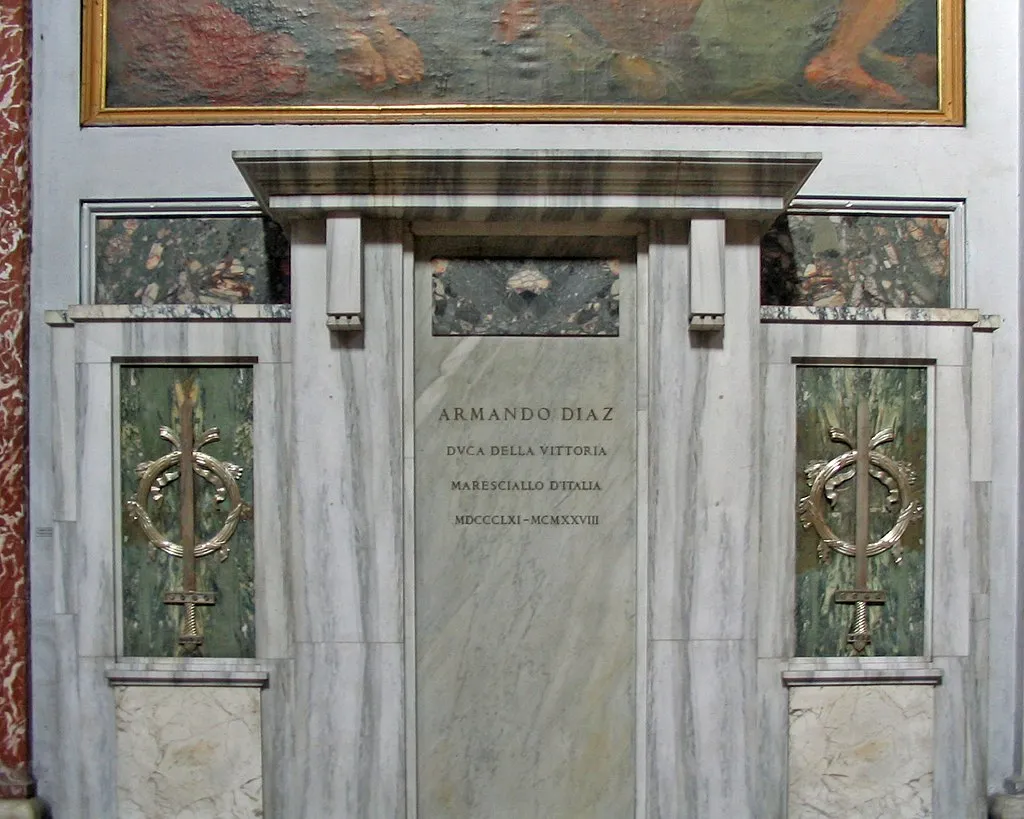
The Angel of Light is a striking bronze sculpture created by Ernesto Lamagna at the end of the Jubilee of 2000. It is the most recent angelic figure added to the basilica and stands out for its modern “baroque-futuristic” style. Unlike the other angels in the basilica, the Angel of Light has a distinct appearance. Lamagna used special acids to age the bronze, creating a grey-iron patina covered in cracks, fissures, and holes. This technique was inspired by Michelangelo’s method of burying his works to achieve a similar aged effect.
The Glass Lantern Light and Time is another remarkable feature in the basilica. Originally, the dome of the Baths of Diocletian had a circular opening that allowed rainwater to enter, collecting in a pool below. When the baths were transformed into a church, the opening had to be closed with a glass window. Initially, lanterns were installed by Michelangelo and Vanvitelli, but these were later demolished. In the 20th century, new lanterns were installed, though they proved unsuitable for the elements. The current lantern, designed by Italian artist Narcissus Quagliata, measures about two meters in diameter and is divided into eight segments made of twenty-four multicolored glass sheets. Inside, three astronomical lenses are placed at varying heights, positioned to converge the sun’s rays downwards. This creates a unique effect: a pink light slowly moves across the floor, mimicking the Earth’s movement in space. The light reaches the center of the floor at the two equinoxes and solstices, indicating midday in Rome.
The Angel of Light is a striking bronze sculpture created by Ernesto Lamagna at the end of the Jubilee of 2000. It is the most recent angelic figure added to the basilica and stands out for its modern “baroque-futuristic” style. Unlike the other angels in the basilica, the Angel of Light has a distinct appearance. Lamagna used special acids to age the bronze, creating a grey-iron patina covered in cracks, fissures, and holes. This technique was inspired by Michelangelo’s method of burying his works to achieve a similar aged effect.
The Glass Lantern Light and Time is another remarkable feature in the basilica. Originally, the dome of the Baths of Diocletian had a circular opening that allowed rainwater to enter, collecting in a pool below. When the baths were transformed into a church, the opening had to be closed with a glass window. Initially, lanterns were installed by Michelangelo and Vanvitelli, but these were later demolished. In the 20th century, new lanterns were installed, though they proved unsuitable for the elements. The current lantern, designed by Italian artist Narcissus Quagliata, measures about two meters in diameter and is divided into eight segments made of twenty-four multicolored glass sheets. Inside, three astronomical lenses are placed at varying heights, positioned to converge the sun’s rays downwards. This creates a unique effect: a pink light slowly moves across the floor, mimicking the Earth’s movement in space. The light reaches the center of the floor at the two equinoxes and solstices, indicating midday in Rome.
Passage Turned Towards the Cruise
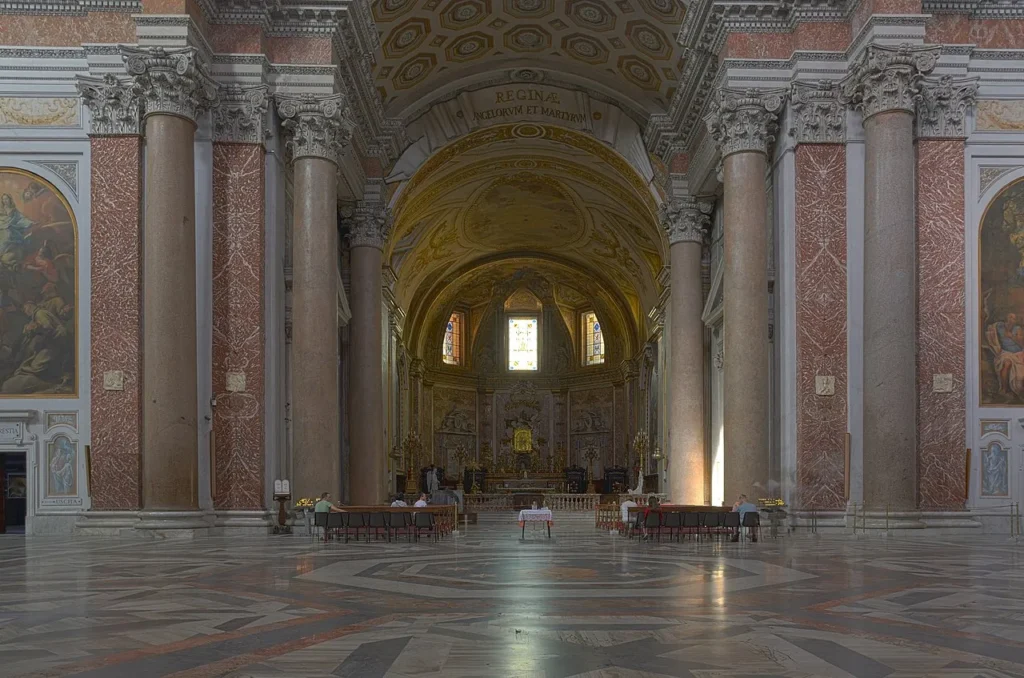
The vaulted passage, visible from the cruise, was remodeled by Vanvitelli, who added four plaster columns that are painted to resemble marble, similar to those found in the red granite transept. In this room, an oval painting by Francesco Trevisani depicts the expulsion from the earthly paradise, while a statue of an angel holding a holy water stoup adds to the room’s serene atmosphere.
Works in the Passageway Facing the Transept
Statue of Saint Bruno:
Created by Jean-Antoine Houdon between 1766 and 1768, the marble statue of Saint Bruno stands across from the now-destroyed statue of Saint John the Baptist. The saint is portrayed wearing a habit, his arms folded and head bowed in a contemplative pose.
Chapel of San Brunone:
Built in 1620 by Monsignor Bartolomeo Povusinski, this chapel features a painting of Saint Brunone by an anonymous seventeenth-century artist. The façade, designed in the style of Michelangelo, was crafted by Vanvitelli.
Chapel of St. Peter:
Constructed in 1635 by Pietro Alfonso Avignonese, the Chapel of St. Peter boasts a façade designed by Vanvitelli. The altar is adorned with an antependium and a painting by Girolamo Muziano, which depicts the delivery of the keys. The walls feature scenes of “Saint Peter Freed by an Angel” and “Saints Peter and Paul” by M. Carloni. At the center of the chapel, a Carrara marble head, donated by Igor Mitoraj, adds a modern touch to the historic space.
The Transept
The transept is situated in the ancient frigidarium of the Baths of Diocletian and has undergone several renovations by Michelangelo, Del Duca, and Vanvitelli. Each of these artists carefully preserved the original structure of the Roman building, maintaining its dimensions. The cross vaults soar to a height of 29 meters, while the columns, including the base, capital, and entablature, measure 17.14 meters in height. Their circumference is 5.10 meters, and their diameter is 1.62 meters. The walls feature pilasters and pilaster strips painted to resemble the red marble of Cottanello. Framed panels contain eight original paintings from St. Peter’s Basilica, which were added in the first half of the 18th century. The transept is illuminated by large thermal windows in the access arches to the side chapels, as well as crescent-shaped windows on the sides. Above these crescents, Niccolò Ricciolini painted depictions of prophets, sibyls, and leaders. The large windows in the access arches to the vestibule and presbytery, which were already in place during Vanvitelli’s time, are distinctive, with their double volute mouldings.
Sundial
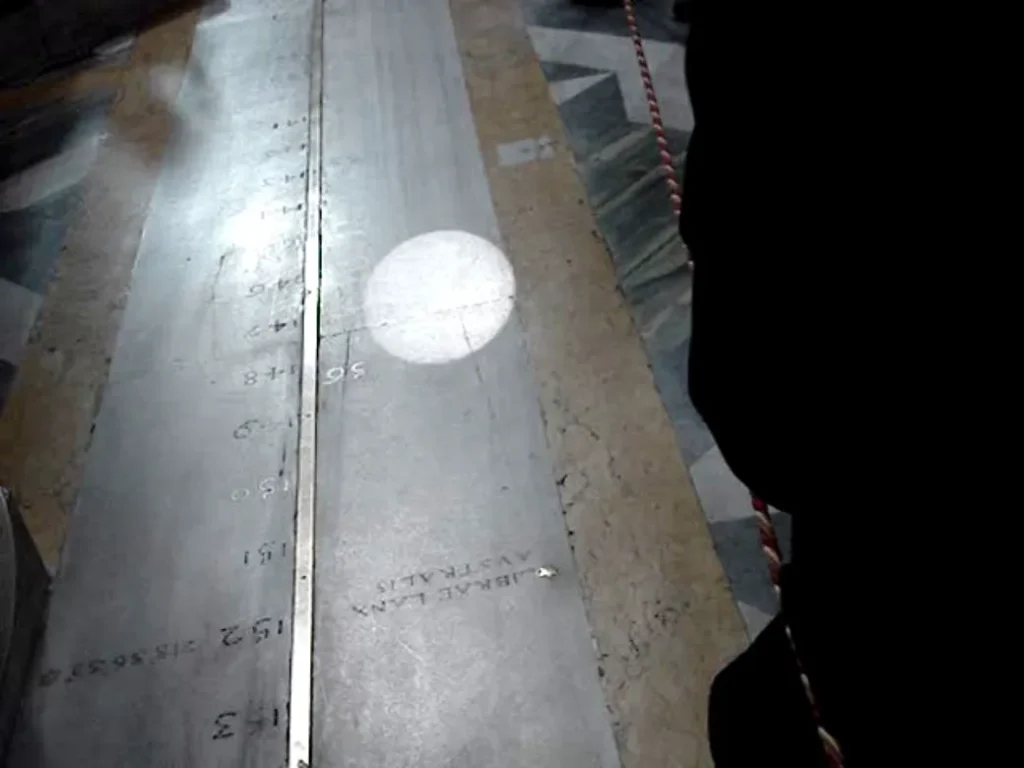
Located on the floor built by Giuseppe Barberi on the right arm of the transept, the sundial was designed by Pope Clement XI and commissioned from Francesco Bianchini for the Jubilee of 1700. Bianchini enlisted the help of astronomers Giacomo Filippo Maraldi and Gian Domenico Cassini, the latter of whom had also worked on the sundial of San Petronio in Bologna. The sundial is surrounded by panels representing the constellations. A plaque nearby indicates that it was used as a sundial until 1846, when it was replaced by the Gianicolo cannon. The purpose of the sundial was to verify the accuracy of the Gregorian calendar and to determine the date of Easter based on the movements of the Sun and Moon.
The gnomon of the sundial is a hole through which the Sun’s light falls onto a bronze line, about 45 meters long, marked on the floor. This point of contact shifts throughout the year. The zodiac signs inlaid in marble along the line represent the changing of the seasons, with Cancer marking the summer solstice and Capricorn representing the winter solstice.
Paintings of the Transept
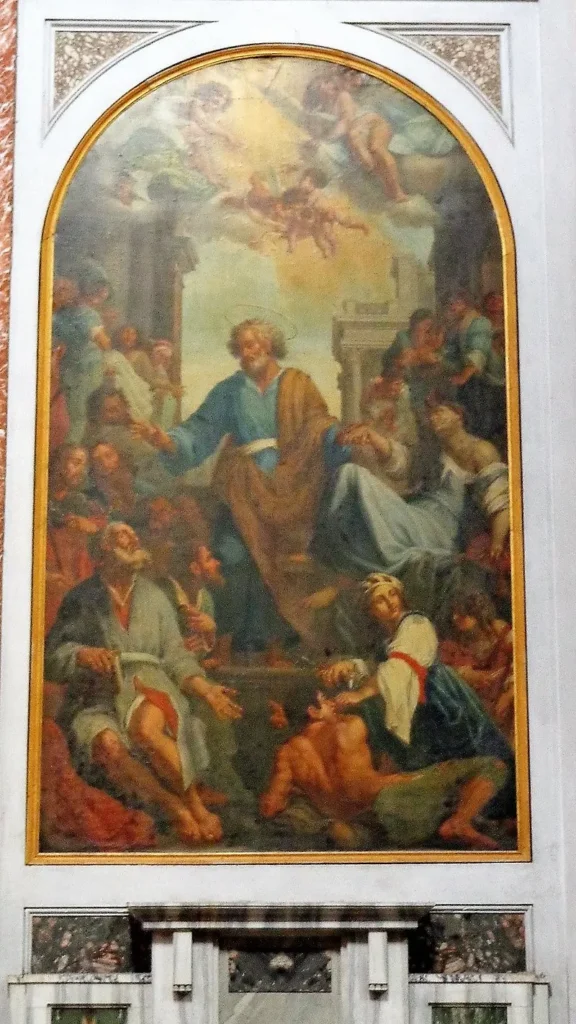
The Crucifixion of St. Peter
This painting is a reproduction of a work by Passignano, created for the Vatican Library by Nicola Ricciolini.
The Fall of Simon Magus (First painting)
This piece is a copy by Pierre Charles Trémolières of Francesco Vanni’s original painting, which is located at the altar of the Sacred Heart in St. Peter’s Basilica. The painting depicts the fall of Simon Magus, who attempted to buy the power to perform miracles from St. Peter. It symbolizes the triumph of Catholic orthodoxy over heresy.
Sermon of St. Jerome
This is the final work of Gerolamo Muziano, with background interventions by Paul Brill. The painting’s bright tones and silver reflections are typical of the Brescia school. Originally created for the altar of San Girolamo in St. Peter’s Basilica, it was later moved to this basilica.
The Immaculate
Painted by Pietro Bianchi, this work was originally located at the altar of the choir chapel in St. Peter’s Basilica, where a mosaic copy now resides. The painting portrays the Immaculate Conception, with Gregory of Nazianzus pointing to the figure, and Francis of Assisi and Anthony of Padua in adoration.
Resurrection of Saint Tabitha
Created by Placido Costanzi for the altar of Tabitha in St. Peter’s Basilica, this painting was later moved to the current basilica after being replaced with a mosaic copy.
The Fall of Simon Magus (Second painting)
This painting by Pompeo Batoni was completed in 1765. It seems that it was not part of the original series of paintings transferred from St. Peter’s Basilica to this basilica.
The Mass of Saint Basil
Made by Pierre Subleyras for the altar of Saint Basil in St. Peter’s Basilica, this painting depicts Saint Peter officiating mass in front of Emperor Valens, who faints during the ceremony. After being relocated to this basilica, a mosaic copy replaced it in St. Peter’s Basilica.
Right and Left Arm of the Transept
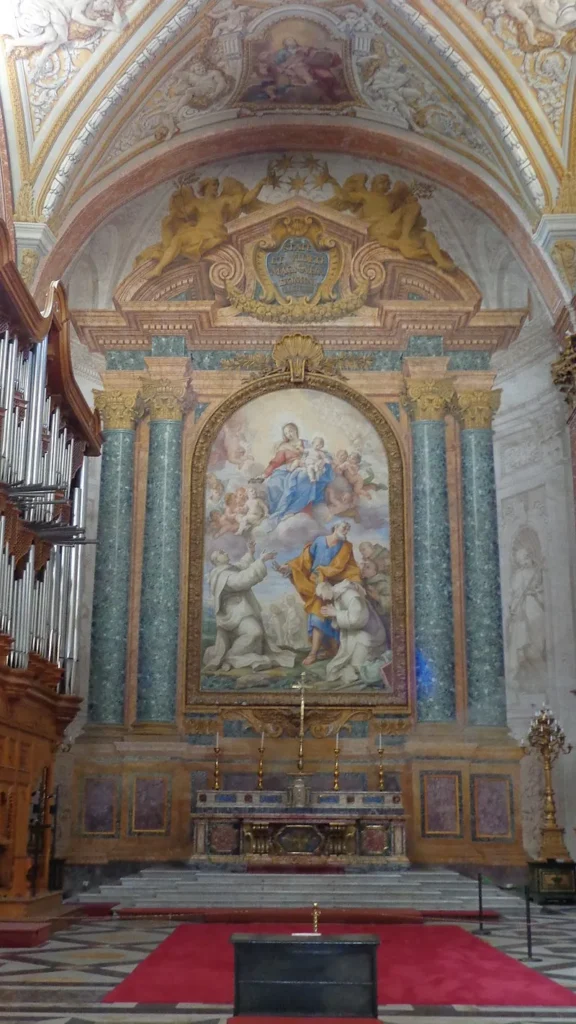
In the right arm of the transept, the Funeral Monument to Armando Diaz stands as a notable tribute. Erected in 1920 by Antonio Muñoz, the monument features a central stele dedicated to the general, flanked by two marble panels adorned with bronze friezes of a sword and laurel wreath, reflecting the general’s military achievements.
On the opposite side in the left arm of the transept, the Chapel of Blessed Niccolò Albergati can be found. Built in 1746 by architect Clemente Orlandi, the chapel is accessed through a segmental arch and boasts a vault decorated by Antonio Bicchierai and Giovanni Mezzetti. The Holy Spirit is prominently featured in the center of the vault, surrounded by cherubs, while the sails of the vault display various doctors of the Church. On the altar is a painting by Ercole Graziani titled A Miracle of Blessed Niccolò Albergati, flanked by two works by Francesco Trevisani titled Battesimo d’Acqua and Battesimo di Desiderio. The chapel also houses two plaster statues of the Angels of Peace and Justice, donated in 1834 by Federico Pettrich.
The transept also holds several other significant funeral monuments. The Funeral Monument to Vittorio Emanuele Orlando, created by Pietro Canonica in 1953, features a sarcophagus made of Siena yellow marble, supported by Carrara marble reliefs and topped with a decorative arch. Similarly, the Funeral Monument to Admiral Paolo Thaon di Revel, built in 1948 by Pietro Canonica, showcases a unique design with a ship-shaped Siena yellow sarcophagus, supported by a red and black base and surrounded by a decorated arch.
Lastly, the painting A Miracle of Saint Peter, originally located in the Quirinal Palace and created by Francesco Mancini, depicts St. Peter’s miracle of healing a paralytic at Porta Speciosa. A mosaic copy of this artwork now resides in St. Peter’s Basilica. These artworks and monuments together highlight the intersection of religious devotion and Italian history within the basilica.
Chapel of San Bruno
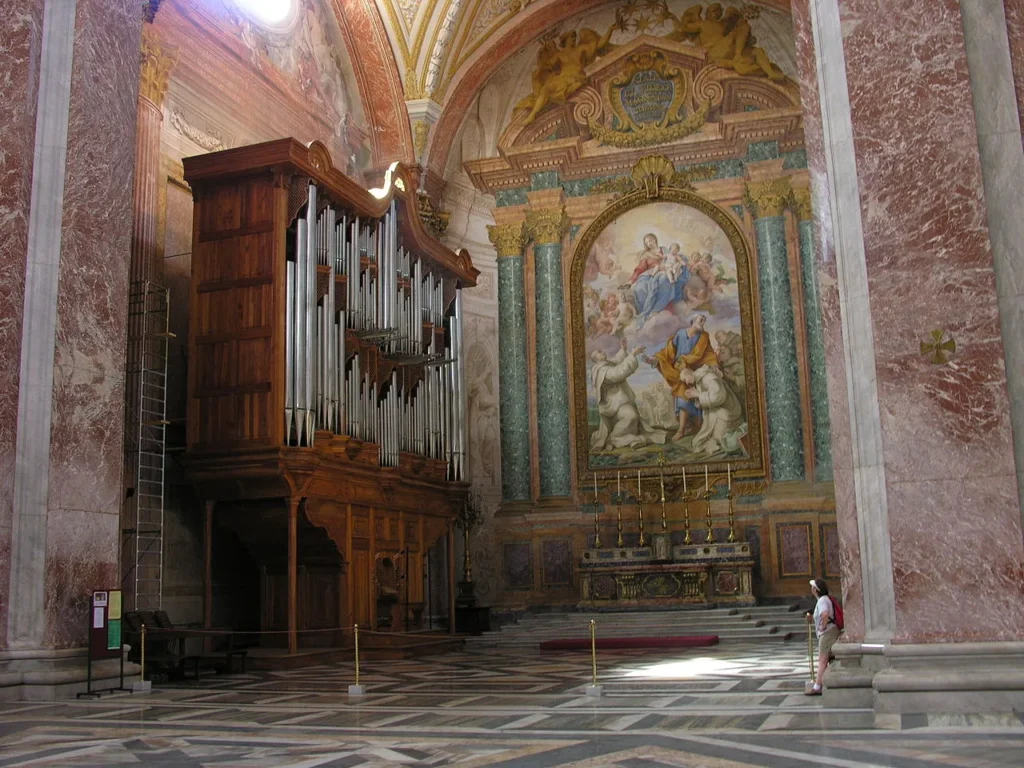
The Chapel of San Bruno was decorated following the design of Carlo Maratta, showcasing a blend of artistic styles and religious significance. The altar is painted with an illusory effect, featuring four serpentine columns supporting a broken pediment trabeation with a coat of arms. Surrounding the altar is a faux choir, complete with niches housing statues. The choir and faux architectural walls were painted by Balletti and Paradisi, creating an immersive illusion. In 1864, Francesco Fontana transformed the Eucharistic table into marble, adding to the chapel’s grandeur. The frescoes on the cross vault, depicting the Evangelists, were created by Andrea Procaccini. On the right wall, statues of Meditation (1874) and Prayer (1875), which are copies of statues from the entrance of the Verano, stand as solemn reminders of devotion. On the left wall, a monumental organ is installed, contributing to the chapel’s acoustic beauty.
The Baptism of Blood is represented through two preparatory cartoons by Francesco Trevisani. These works, along with those in the Albergati Chapel, form a trilogy of baptism in its three forms: water, desire, and blood (martyrdom). Unlike the final mosaic versions in the Vatican Basilica, these cartoons are characterized by light and superficial drawings, offering a raw glimpse into the artist’s process.
At the center of the altar, the Apparition of the Virgin to Saint Bruno is depicted in an altarpiece painted by Giovanni Odazzi in oil. This work marks Odazzi’s transition from the Baroque to the Rococo style, capturing the spiritual moment with elegance and grace.
Passageway Facing the Presbytery
The turned passage leads not only to the presbytery but also to two chapels: the Chapel of San Giacinto on the right and the Chapel of the Savior on the left. Both chapels were modernized by Vanvitelli with inspiration drawn from Michelangelo’s work. Unlike an architraved space, the chapels feature pilasters framing arched entrances, closed off by wrought iron gates adorned with brass studs and golden palms designed by Vanvitelli. The lowered arch leading to the passage from the cross vault is embellished with two angels, while the opposite side, toward the presbytery, displays a cartouche inscribed with Reginae Angelorum et Martyrum. The rich ornamentation skillfully hides the varying heights of the different access points. The passage vault is coffered, mirroring the vestibule’s style.
Chapels of the Passage Facing the Presbytery
Chapel of San Giacinto: Founded in 1608 by Alessandro Litta, this chapel features an altar with a painting by Giovanni Baglione. Along the sides, paintings of saints, including Saint Cecilia and Saint Francis of Assisi receiving the stigmata, adorn the walls. The vault depicts God and angels.
Chapel of the Savior: The oldest chapel in the church, built in 1574, was originally owned by the De Cinque family, later passing to the Catalani family, as evidenced by the coats of arms on either side. A significant historical work, the painting on the right wall recalls the indulgences granted by Pope Gregory VII to the Confraternity of the Seven Angels. The altar’s decorations depict The Incarnation of Jesus and The Adoration of the Seven Angels, painted by Domenico da Modena. Additionally, 24 small paintings illustrating the stories of Christ are attributed to Hendrik van der Boeck. The vault features a scene of God and Saint Michael the Archangel. The side walls contain Souls in Purgatory and The Praying Pontiff, painted by Giulio Mazzoni, depicting notable figures associated with the church’s founding, such as Pius IV, Charles V, and Vittoria Colonna.
Presbytery
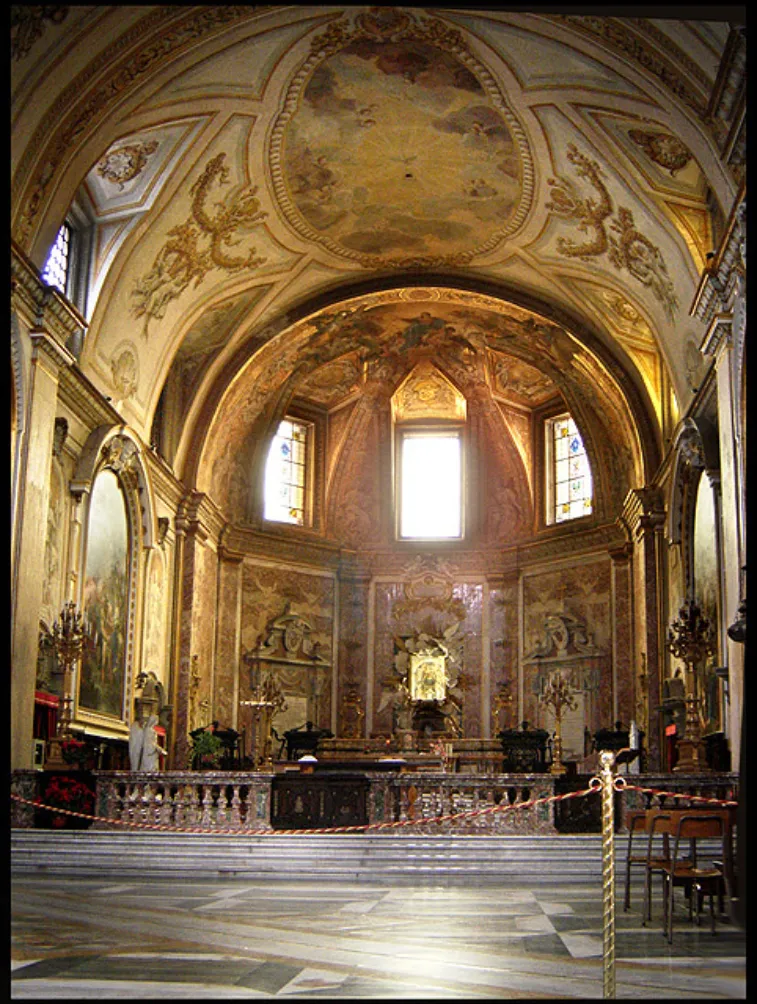
The presbytery was designed by architect Clemente Orlandi, with the choir envisioned by Vanvitelli, who also decorated the entire presbytery area. The apse takes on a polygonal shape, centered around the high altar, similar to the one Vanvitelli designed for the Royal Palace of Caserta. The decorative flow was interrupted in 1867 when the altar was moved to accommodate the choir. The choir is protected by a metal grille, decorated with the initials and golden Carthusian stars, as well as harp-shaped gates designed by Angelo Santini. The gates feature ornaments created by Giuseppe della Riccia. Just before the altar, one can view two works by Innocenzo Orlandi from 1866: The Angel with the Eagle and The Chair, with the latter supported by a bull and lion, symbolizing the evangelists.
Paintings of the Presbytery
Presentation of Mary at the Temple: Painted by Giovanni Francesco Romanelli, this artwork adorns the presbytery.
Martyrdom of Saint Sebastian: Created by Domenichino using oil on wall technique for the Vatican Basilica, this piece suffered some damage during its removal.
Madonna Enthroned with Seven Angels in the Apse: In the red-painted pentagonal apse, two doors surmounting the busts of Carlo Borromeo and Pope Pius IV stand next to commemorative plaques for the pontiff and Cardinal Serbelloni, the church’s first titular. The centerpiece is Madonna degli Angeli, painted by Antonio Del Duca in Venice in 1543, showcasing the Madonna breastfeeding Jesus, known as Madonna del latte. Archangels Michael and Gabriel, depicted on the left and right respectively, support the crown above the Virgin Mary’s head, with the other archangels holding scrolls containing their duties.
Baptism of Jesus: Painted by Carlo Maratta, this work was one of the first to be transferred from the Vatican Basilica. Despite Maratta’s later age, his portrayal of John the Baptist and Jesus shows no artistic fatigue, with both figures illuminated distinctly from the surrounding angels. The influence of the Correggio school is evident in Maratta’s work, as he was a pupil of Andrea Sacchi.
Death of Ananias and Sapphira: Created by Pomarancio in 1604, this late sixteenth-century Mannerist style painting depicts the tragic death of Ananias and Sapphira.
Cybo Chapel (Chapel of the Relics)
Constructed in 1742 by Cardinal Camillo Cybo to house relics related to the construction of the baths, the chapel also contains relics of Church Doctors such as Jerome, Ambrose, Augustine, and Gregory, which Cybo had kept in his palace. The chapel’s decorations were designed by Nicola Ricciolini.
Wooden Altar with the Deposition
The Eucharistic table features a bronze antependium created by Umberto Mastroianni in 1928, depicting the deposition. This early work by Mastroianni displays a pronounced chiaroscuro effect, indicative of his style before he transitioned to futurist and abstract art.
Epiphany Chapel (Carthusians Choir)
From the portal on the left of the altar, one can access the current sacristy with a semi-cylindrical vault. This leads to the Michelangelo sacristy, which took on its current appearance between 1720 and 1730, with a pavilion vault specifically for the Carthusian choir. The Carthusian fathers’ choir was relocated here by order of Pope Benedict XIII and consecrated on October 6, 1727. The choir features a Renaissance-style painting, marking the chapel’s name change. Prior to the altar’s installation, Luigi Garzi decorated the room with late Baroque scenes from the life of Saint Bruno.
Pipe Organs
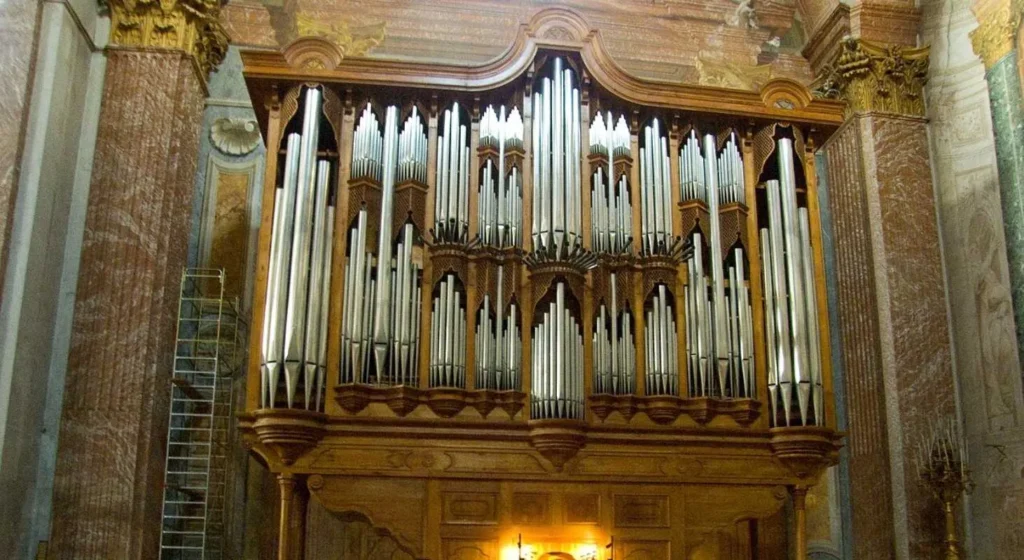
Organ of the Chapel of San Bruno
Located on the left wall of the Chapel of San Bruno, this organ was built around 1990 by Bartolomeo Formentelli and was inaugurated during the Jubilee Year 2000. It features 77 registers spread across four manuals, each with 56 notes, and a straight pedalboard with 30 notes. The instrument operates with entirely mechanical transmission. Initially intended for the Basilica of Santa Maria in Aracoeli, it was later relocated to the Basilica of Santa Maria degli Angeli e dei Martiri. The organ was designed in accordance with the French organ school principles. Its case is crafted from solid cherry, walnut, and chestnut woods, housing 5,400 meticulously hand-worked tin and wooden pipes, which together create the rich sound of the instrument.
Presbytery Organ
Hidden behind the high altar in the apse basin is a pipe organ built in 1913 by Giovanni Tamburini. This smaller organ features a double-compartment wind chest controlled by a console with two keyboards, each with 58 notes, and a 30-note pedalboard. Originally pneumatic, the organ’s transmission has since been updated to an entirely electric system.
Feast Day
Feast Day : 2nd August
The feast day of the Basilica of St. Mary of the Angels and the Martyrs in Rome is celebrated annually on August 2nd.
Church Mass Timing
Monday : 6.00 PM
Tuesday : 6.00 PM
Wednesday : 6.00 PM
Thursday : 6.00 PM
Friday : 6.00 PM
Saturday : 6.30 PM
Sunday : 10.30 AM 12.00 PM and 6.30 PM
Church Opening Time:
Monday : 8:00 am – 1:00 pm, 4:00 pm – 7:00 pm
Tuesday : 8:00 am – 1:00 pm, 4:00 pm – 7:00 pm
Wednesday : 8:00 am – 1:00 pm, 4:00 pm – 7:00 pm
Thursday : 8:00 am – 1:00 pm, 4:00 pm – 7:00 pm
Friday : 8:00 am – 1:00 pm, 4:00 pm – 7:00 pm
Saturday : 10:00 am – 1:00 pm, 4:00 pm – 7:00 pm
Sunday : 10:00 am – 1:00 pm, 4:00 pm – 7:00 pm
Contact Info
Address :
P.za della Repubblica, 00185 Roma RM, Italy.
Phone : +39064880812
Accommodations
Connectivities
Airway
Leonardo da Vinci International Airport (Fiumicino) to Basilica di Santa Maria degli Angeli e dei Martiri Roma distance between 39 min (30.6 km) via A91.
Railway
Roma Termini Station to Basilica di Santa Maria degli Angeli e dei Martiri Roma distance between 7 min (1.4 km) via Via Napoleone III.

